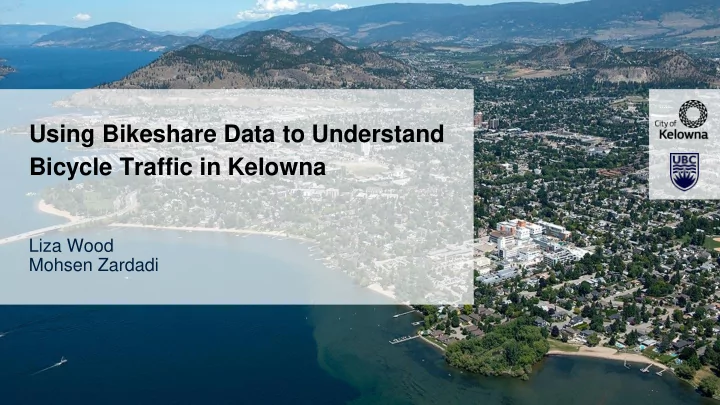

Using Bikeshare Data to Understand Bicycle Traffic in Kelowna Liza Wood Mohsen Zardadi 1
Who We Are Liza Wood, P.Eng Mohsen Zardadi, Ph.D. Director, Research and Data Science Data Scientist Two Hat Security Terrasense Analytics 2
Agenda ● Introduction Project Goal ○ Data and Challenges ○ ● Analysis Tools ○ Finding Routes ○ Counting Bikeshare Trips ○ Evaluation of Path-Finding Models ○ Estimation of Average Daily Bicycle traffic ○ ● Final Visualization ● Conclusion 3
Project Goal Using the bikeshare and Eco-Counter data, estimate and visualize the Average Daily Bicycling (ADB) volumes for downtown Kelowna. ADB by segment produced by combining GPS and counter data, Montreal 4
Data and Challenges Waterfront ● 2018 Dropbike Bikeshare Pilot Dockless bikeshare - 3 months ○ Cawston St. Latitude, Longitude, Timestamp for each trip ○ Cleaned data: 8,853 trips ○ Challenge: GPS Low Resolution, Low Accuracy ● Eco-Counters Ethel St. Challenge: Low bikeshare count compared City Park to counters 5
Data and Challenges 6
Analysis Tools ● QGIS Visualization ○ ● R Statistical Analysis ○ ● OSMnx Python Library OpenStreetMap and Networkx ○ Turns the map into a graph ○ Each street is an edge ■ Each intersection is a node ■ Algorithms to calculate distances ○ and paths 7
Finding Routes: Snap GPS Points To Graph ● Found nearest node in the graph for each GPS point ● Removed GPS points that are at least 150m far away of the calculated nearest node ● Removed any trips with less than three points This left us with 8815 trips and 95905 GPS points. 8
Finding Routes: Connect The Points ● OSMnx calculates shortest path between nodes based on given numerical weights for each edge ● Tried 8 different path-finding models based on: Distance ○ Route Type Preference ○ Road configuration ○ Source: Wikipedia 9
Counting Bikeshare Trips 10
Evaluation of Path-Finding Models Criteria: ● Visual ● Speed ● Percentage split between Eco-Counter locations ● Linear regression of Eco- Counter data vs. bikeshare data at City Park Winner: ● Shortest distance 11
Estimation of ADB: Differences In Traffic 12
Estimation of ADB: Approach Least Squares Optimization ● Find a single multiplier ( m ) such that: m x bikeshare = counter ● Minimize the following equation across counters: f(x) = 𝚻 ( ( m x bikeshare - counter) 2 x split ) m = 159 ● Calculate ADB for each segment: ADB = ( m x bikeshare)/91 13
Final Visualization 14
Conclusions Using OSMnx to apply graph theory gave us the mapping and path- ● finding tools needed. The best path-finding model was shortest distance between points. ● Traffic patterns are different at each counter. ● Bikeshare traffic is different from overall traffic recorded by the ○ counters. Least squares optimization gave us an estimate of ADB. ● Total count of bikeshare trips used for understanding how bikeshare ● users cycled through the network. 15
Thank You! 16
Questions? 17
Acknowledgements Marzi Rafieenia - Project Team Member Academic Papers Cited: City of Kelowna: ● Boeing, G. (2017). OSMnx: New Methods for Acquiring, Constructing, Analyzing, and Visualizing Complex Street Networks. Computers, ● Matt Worona Environment and Urban Systems , 65, 126-139 ● Kamil Rogowski ● Strauss, J. (2015). New Methods for Modeling and Integrating Bicycle Activity and Injury Risk in an UBCO: Urban Road Network. Montreal: McGill University ● Winters, M., & Teschke, K. (2010). Route ● Dr. Scott Fazackerley Preferences Among Adults in the Near Market for ● Dr. Khalad Hasan Bicycling: Findings of the Cycling in Cities Study. The Science of Health Promotion , 40-47. ● Dr. John Braun ● Dr. Heinz Bauschke ● Joyce Epp (TA) ● Matt Fritter (TA) ● Jiachen Wei (QGIS expertise) 18
19
Recommend
More recommend